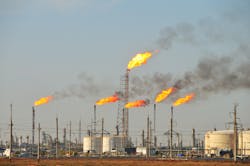The gaseous byproducts of crude oil are toxic and must be controlled. Over-pressure situations can put the plant and personnel in danger, so pressure relief valves (PRVs) are installed that send gases and vapors to a flare stack for burning. In the U.S., the Environmental Protection Agency (EPA) requires a detailed accounting of all releases and issues fines when regulatory limits are not met.
But it has traditionally been difficult for petroleum producers to provide an accurate assessment of the state of PRVs before, during and after a release event. Staying within those limits takes a team effort—including operations, maintenance, tech services, quality, environment and reliability—according to an instrumentation specialist for one of the largest petroleum producers in the U.S., presenting at the Emerson Global Users Exchange last week in Minneapolis.
It is always an operational challenge to identify the source of leaks, he said. Small leaks are difficult to detect because they might not be audible to human ears. PRVs can also release continuously, a phenomenon called “chattering,” or get stuck open. Using process information to identify the location of the release can take hours to days of expert data analysis. Every minute spent identifying which PRV is releasing leads to increased emissions, regulatory fines and lost production.
The petroleum company recently deployed Emerson Rosemount 708 acoustic transmitters to monitor its PRVs for open, close and leaking conditions. “Knowing the status of each PRV is a fundamental element to achieving flare system operational excellence,” the company’s spokesman said.
Cost-justified loss avoidance
With two flares and four headers, the petroleum company installed the transmitters on 50 PRVs with high hydrocarbon flow. “The non-invasive wireless acoustic transmitter was attached directly to the outlet side of the process piping of each valve,” said the company spokesman. This solution allows individual monitoring of PRVs without a lot of added infrastructure and cost.
The team was able to leverage wireless infrastructure that was previously installed for safety showers, further minimizing the investment needed. And the process did not need to be stopped or disrupted while the transmitters were installed—a major win. The transmitters were easily installed within a month.
The system is seamlessly integrated via WirelessHART. Operators can graph any relief event from the onset until stopped. The recommended scan rate is set at 32 seconds, giving the best balance between need information and power module life (transmitter battery life is an impressive seven to eight years).
The team validates that a PRV has truly released by seeing an increase in flow rate in the unit’s flare header. It can pinpoint the affected valve immediately after a flow alarm sounds. The operators for the unit are called immediately.
The ability to pinpoint broken or stuck-open PRVs saves weeks and sometimes even months of high-flow releases. The ability to detect “undetectable” slow or intermittent releases is equally valuable. Over time, all these actions combined have a significant impact on the total emissions and hydrocarbon flow to the flare.
The results of the monitoring include:
- Reduction in loss of hydrocarbon to the flare system.
- Capturing before and after data for the duration of PRV lifts.
- Timely detection and intervention of faulty valves.
- Improved operation of process units.
- Tamper-proof environmental reporting.
- Reduction in post-lift reports.
- Time stamps correlated with process conditions and timely intervention, enabling better environmental stewardship.
“The acoustic data shows when we are operating outside of limits, and we now have more confidence to increase the throughput of the units,” said the instrumentation specialist.
The project paid for itself within five months with an estimated return on investment (ROI) at 271 percent annualized over 20 years, he added.

